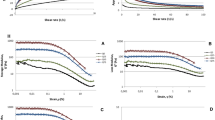Abstract
Rice flour-based batter is an alternative for wheat flour-based batter for consumers with wheat allergy or wheat intolerance. Further advantage of rice flour in batter is its ability to reduce oil uptake. However, due to its low-protein content, high amylose, and small granule size, rice flour-based batter possesses poor adhesion property. The aim of this study was to investigate the effect of the addition of hydroxypropyl methylcellulose (HPMC); a hydrocolloid, on rheological properties, coating pickup, and oil absorption of HPMC-rice-based fried batter. Rheological properties of rice flour-based batters containing HPMC with different degrees of substitution (DS) and concentrations were determined. In steady-shear measurements, the addition of HPMC; E4M (DS = 1.9) and K4M (DS = 1.4), led to the increase of apparent viscosity, yield stress, and consistency index. K4M rice flour batters showed shear-thickening behavior (n > 1) with syneresis. HPMC increased the complex modulus (G*) of batters, where storage moduli (G′) were higher than loss moduli (G″). The crossover points increased with increasing HPMC concentration. HPMC addition increased the coating pickup of fresh carrot sticks and less coating loss was observed with K4M. Rice batter formulated with 0.5% E4M provided deep-fried crust with 26% lower oil content compared to the control crust.


Similar content being viewed by others
References
Alloncle, M., Lefebore, J., Llamas, G., & Doublier, J. L. (1989). Rheology of cereal starch-galactomannan gels. Cereal Chemistry, 66, 90–93.
AOAC (1995) Official Methods of Analysis. Arlington, VA.
Balasubramaniam, V. M., Chinnan, M. S., Malliparjunan, P., & Phillips, R. D. (1997). The effect of edible film on oil uptake and moisture retention of a deep-fat fried poultry product. Journal of Food Process Engineering, 20, 17–29.
Bemiller, J. N., & Whistler, R. L. (1996). Carbohydrates. In O. R. Fennema (Ed.), Food chemistry (3rd ed.). New York: Marcel Dekker, Inc.
Bouchon, P., Aguilera, J. M., & Pyle, D. L. (2003). Structure oil-absorption relationships during deep-fat frying. Journal of Food Science, 68, 2711–2716.
Greminger, G. K., & Krumel, K. L. (1980). Alkyl and hydroxyalkylalkylcellulose. In R. L. Davidson (Ed.), Handbook of water-soluble gums and resins. New York: McGraw-Hill.
Gujral, H. S., Guardiola, I., Carbonell, J. V., & Rosell, C. M. (2003). Effect of cyclodextrinase on dough rheology and bread quality from rice flour. Journal of Agricultural and Food Chemistry, 51, 3814–3818.
Hoseney RC (1994). Starch. IN RC Hoseney (Ed.) Principles of Cereal Science and Technology. St.Paul, Minnesota, American Society of Cereal Chemicts.
Hsia, H. Y., Smith, D. M., & Steffe, J. F. (1992). Rheological properties and adhesion characteristics of flour-based batters for chicken nuggets as affected by these hydrocolloids. Journal of Food Science, 57, 16–18, 24.
Juliano, B. O. (1971). A simplified assay for milled rice amylose. Cereal Science Today, 16, 334–338, 340, 360.
Lii, C-y, Tomasik, P., Hung, W.-L., & Lai, V. M. F. (2002). Revised look at the interaction of starch with electrolyte: effect of salts of metals from the first non-transition group. Food Hydrocolloids, 16, 35–45.
Lineback, D. R. (1986). Current concepts of starch structure and its impact on properties. Journal of the Japanese Society of Starch Science, 33, 80–88.
Meyers, M. A., & Conklin, J. R. (1990). A method of inhibiting oil absorption in coated-fried foods using hydroxypropyl methylcellulose Book A method of inhibiting oil absorption in coated-fried foods using hydroxypropyl methylcellulose. City. The Dow Chemical Company (Midland, MI).
Mukprasirt, A., Herald, T. J., Boyle, D. L., & Rausch, K. D. (2000). Adhesion of Rice flour-based batter to chicken drumsticks evaluated by laser scanning confocal microscopy and texture analysis. Poultry Science, 79, 1356–1363.
Mukprasirt, A., Herald, T. J., & Seib, P. A. (2002). Pasting characteristics of rice flour-based batter compared to wheat flour-based batter. Journal of Food Quality, 25, 139–154.
Ogan, S. F., Sahin, S., & Sumnu, G. (2005). Effect of soy and rice flour addition on batter rheology and quality of deep-fat fried chicken nuggets. Journal of Food Engineering, 71, 127–132.
Priya, R., Singhal, R. S., & Kulkarni, P. R. (1996). Carboxymethylcellulose and hydroxypropylcellulose as additives in reduction of oil content in batter based deep-fat fried boondis. Carbohydrate Polymers, 29, 333–335.
Rao, M. A., & Kenny, J. F. (1975). Flow properties of selected food gums. Canadian Institute of Food Science and Technology Journal, 8, 142–148.
Rao, M. A., & Tattiyakul, J. (1999). Granule size and rheological behavior of heated tapioca starch dispersions. Carbohydrate Polymers, 38, 123–132.
Sabanis, D., & Tzia, C. (2009). Effect of rice, corn and soy flour addition on characteristics of bread produced from different wheat cultivars. Food and Bioprocess Technology, 2, 68–79.
Sanz, T., Fernandez, M. A., Salvador, A., Munoz, J., & Fiszman, S. M. (2005). Thermogelation properties of methylcellulose (MC) and their effect on a batter formula. Food Hydrocolloids, 19, 141–147.
Shih, F., & Daigle, K. (1999). Oil uptake properties of fried batters from rice flour. Journal of Agricultural and Food Chemistry, 47, 1611–1615.
Sivaramakrishnan, H. P., Senge, B., & Chattopadhyay, P. K. (2004). Rheological properties of rice dough for making rice bread. Journal of Food Engineering, 62, 37–45.
Tiwari, U., Gunasekaran, M., Jaganmohan, R., Alagusundaram, K., & Tiwari, B. (2010). Quality characteristic and shelf life studies of deep-fried snack prepared from rice brokens and legumes by-product. Food and Bioprocess Technology, doi:10.1007/s11947-009-0219-6, in press.
Xue, J., & Ngadi, M. (2006). Rheological properties of batter systems formulated using different flour combinations. Journal of Food Engineering, 77, 334–341.
Yoshimura, M., Takaya, T., & Nishinari, K. (1998). Rheological studies on mixtures of corn starch and konjac-glucomannan. Carbohydrate Polymers, 35, 71–79.
Author information
Authors and Affiliations
Corresponding author
Rights and permissions
About this article
Cite this article
Amboon, W., Tulyathan, V. & Tattiyakul, J. Effect of Hydroxypropyl Methylcellulose on Rheological Properties, Coating Pickup, and Oil Content of Rice Flour-Based Batters. Food Bioprocess Technol 5, 601–608 (2012). https://doi.org/10.1007/s11947-010-0327-3
Received:
Accepted:
Published:
Issue Date:
DOI: https://doi.org/10.1007/s11947-010-0327-3




